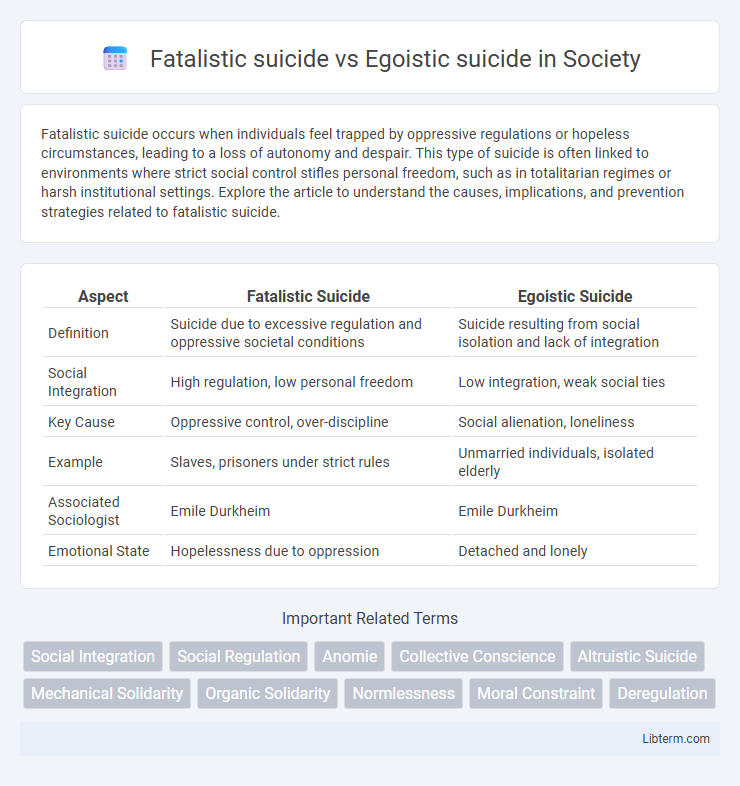Fatalistic suicide occurs when individuals feel trapped by oppressive regulations or hopeless circumstances, leading to a loss of autonomy and despair. This type of suicide is often linked to environments where strict social control stifles personal freedom, such as in totalitarian regimes or harsh institutional settings. Explore the article to understand the causes, implications, and prevention strategies related to fatalistic suicide.
Table of Comparison
| Aspect | Fatalistic Suicide | Egoistic Suicide |
|---|---|---|
| Definition | Suicide due to excessive regulation and oppressive societal conditions | Suicide resulting from social isolation and lack of integration |
| Social Integration | High regulation, low personal freedom | Low integration, weak social ties |
| Key Cause | Oppressive control, over-discipline | Social alienation, loneliness |
| Example | Slaves, prisoners under strict rules | Unmarried individuals, isolated elderly |
| Associated Sociologist | Emile Durkheim | Emile Durkheim |
| Emotional State | Hopelessness due to oppression | Detached and lonely |
Understanding Fatalistic Suicide
Fatalistic suicide occurs under conditions of excessive regulation and oppressive discipline, where individuals feel trapped by strict social norms and foresee no change in their harsh circumstances. Understanding fatalistic suicide requires examining environments such as brutal prisons or totalitarian regimes where personal freedom is drastically curtailed, leading to despair and hopelessness. This contrasts with egoistic suicide, which stems from weakened social integration and feelings of alienation rather than excessive control.
Defining Egoistic Suicide
Egoistic suicide occurs when individuals feel detached from social groups, leading to a sense of isolation and meaninglessness. Emile Durkheim defined this type of suicide as resulting from low social integration, where people lack strong connections to family, community, or society. In contrast, fatalistic suicide arises from excessive regulation and oppressive social conditions, causing individuals to feel trapped with no hope for change.
Historical Context of Suicide Typologies
Fatalistic and egoistic suicides are key categories in Emile Durkheim's seminal 1897 work, "Suicide," which established a sociological framework for understanding suicide based on individuals' social integration and regulation. Fatalistic suicide occurs under oppressive social conditions with excessive regulation, such as in totalitarian regimes or slavery, where individuals feel trapped by strict norms and lack autonomy. Egoistic suicide, conversely, arises from weak social integration, often observed in social isolation or detachment from community, prevalent in modern industrial societies experiencing rapid social change.
Key Characteristics of Fatalistic Suicide
Fatalistic suicide is characterized by excessive regulation, where individuals experience oppressive discipline and a lack of freedom, often seen in total institutions or oppressive societies. Key features include a perception of life being unbearable due to strict rules, limited autonomy, and the anticipation of desperate outcomes. This contrasts with egoistic suicide, which stems from social isolation and weak integration into society.
Main Features of Egoistic Suicide
Egoistic suicide occurs when individuals feel isolated due to weak social integration, leading to a sense of meaninglessness and detachment from communal bonds. It is characterized by a lack of belonging, low social support, and diminished regulation by societal norms. The main features include feelings of loneliness, social alienation, and an absence of communal identity, which increase vulnerability to self-inflicted death.
Causes and Social Factors of Fatalistic Suicide
Fatalistic suicide occurs under oppressive social conditions where individuals face excessive regulation and loss of autonomy, such as in totalitarian regimes or rigid institutional settings. The causes include unbearable discipline, high levels of control, and a lack of freedom, which lead to feelings of hopelessness and despair. Social factors contributing to fatalistic suicide involve extreme oppression, strict societal norms, and the inability to escape or change one's constrained environment.
Social Disintegration and Egoistic Suicide
Egoistic suicide occurs when individuals experience social disintegration, feeling detached from societal norms and lacking meaningful connections, leading to a sense of purposelessness. This type of suicide arises from weak social ties and insufficient integration into community or groups, resulting in alienation and loneliness. In contrast, fatalistic suicide stems from excessive regulation and oppressive social constraints, whereas egoistic suicide is characterized by a deficit in social integration.
Comparative Analysis: Fatalistic vs. Egoistic Suicide
Fatalistic suicide stems from excessive regulation and oppressive discipline, where individuals feel trapped by harsh constraints, commonly observed in totalitarian regimes or extreme social suppression. In contrast, egoistic suicide arises from insufficient social integration, leading to feelings of isolation and meaninglessness, often seen in societies with weakened communal bonds or individuals detached from social groups. Comparative analysis highlights that while fatalistic suicide results from overwhelming control, egoistic suicide is driven by a lack of belonging and societal support, illustrating opposing social dynamics influencing suicidal behavior.
Sociological Theories Influencing Suicide Typologies
Fatalistic suicide arises in overly regulated societies where individuals experience oppressive discipline and lack of autonomy, as described in Durkheim's sociological framework. Egoistic suicide occurs when individuals feel disconnected or isolated from social groups, leading to diminished social integration. Both typologies reflect the critical influence of social structures and community bonds on individual tendencies toward suicide in Durkheimian theory.
Prevention Strategies for Fatalistic and Egoistic Suicide
Prevention strategies for fatalistic suicide emphasize reducing oppressive social conditions by promoting individual autonomy and improving mental health support within highly controlled environments, such as prisons or strict institutions. In contrast, preventing egoistic suicide focuses on strengthening social integration through community engagement, fostering supportive relationships, and enhancing a sense of belonging to counter feelings of isolation and social disconnection. Tailored interventions that address the specific social dynamics and psychological needs underlying each suicide type are crucial for effective prevention.
Fatalistic suicide Infographic

 libterm.com
libterm.com